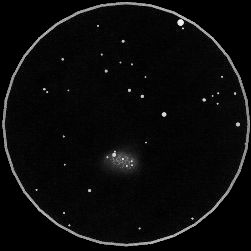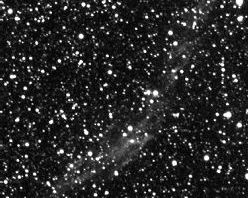
M 31 and M32
60x40 refractor
North is down

This "galaxymire" will enable you to regulate your screen in order to obtain all the gray values of the images presented here.
You might think that traditional, low-cost 60mm refractors with long focal ratios offer little chance for deep sky observation.
It is generally admitted that you need a short focal ratio to see star clusters, nebulae and galaxies.
But this applies only to very large objects, which actually are only a small portion of what you can observe in the deep sky.
Magnification can be very useful and sometimes indispensable to provide contrast and a dark background sky. As for the planets, deep sky vision can be educated.
With such instruments, "Deep Sky Maniacs" can see all the Messier objects, and as many NGC ! So what about giving it a try ?
434 Deep-sky objects !
Objects from the book (257)
Objects not in the book observed by the author (67)
Additionnal objects from G. Gauthier's list (55mm refractor) (84)
Other objects from the southern hemisphere, drawn by Laurent Ferrero (26)
Double stars
They are sometimes forgotten, but certain are very interesting to spot, especially for their colours: the best way to see the colouring of stars, is to observe two of them (with different colours) "side by side". Some of these doubles are very coloured, like Albireo or Gamma Andromeda.Of another quality: if they are bright, it is not necessary to have a perfectly dark sky to observe them.

Albireo (c) Guide5, North is down.
Field : 30', limiting mag. : 10

M 73 (c) Guide5. North is down.
Field : 30', limiting mag. : 12
Stellar asterisms and clouds
Asterisms are star groupings with only an apparent bond between them; M 73, in the Messier catalogue, is one of them.A stellar cloud is a very dense "piece of Milky Way", as for example M 24.
Open clusters
Open clusters are the easiest objects to see with such instruments. I recommend them to beginners. At first, they are the most accessible objects with a 60 mm scope, but if you are a galaxy lover, you will be able to go beyond them !
M 52, 60x40R, 1° field.North is down.

Stock 2, 60x20R, 1°26' field, North is down
As a consequence, during such nights, do not limit cluster hunting to Messier and NGC's, and you will have beautiful surprises!

NGC 1528, 60x20R, 1°26' field, North is down.

IC 4756, 60x20R, 1°26' field, North is down.

M 4, 60x89 R, 30' field. North is down.
Globular clusters
Do you know that half of the globular clusters listed in our galaxy are already visible in a 60 mm refractor ? It is quite difficult to solve them. Yet some clusters as M 4 begin to show some faint stars under pure skies, and M 22 is even obviously granulous.Diffuse nebulae
Compared to the preceding objects, only a few diffuse nebulas are observable in 60mm refractors; half of them are in Orion. Among the "celebrities" (M42, M8, M17...) we find more discrete nebulas surrounding stars (NGC 2023, NGC 1999....)
M 8, 60x40R, 1° field. North is down

M 57, 60x89 R, 30' field. North is down
Planetary nebulae
Three categories can be distinguished: "faint fuzzies" (NGC 246, NGC 1360), compact, quasi stellar ones (NGC 7009, NGC 6826), and celebrities (M27, M57...)Supernovae and their remnants
Supernovae are very rare events to observe with a 60mm. However in 2011 a star exploding in M101 was visible (see more). For the remnants, with 60 mm scopes, it's easy, there are only M 1 in Taurus and the Veil Nebula in Cygnus (NGC 6992 was glimpsed in my refractor, but not the Witch's Broom Nebula, NGC 6960)..Though very faint, Thor's Helmet (NGC 2359), not a supernova remnant but a nebulosity surrounding a Wolf Rayet star, is visible...

NGC 6992, The Veil Nebula - North is down
60/700 R + SBIG ST6 CCD camera.
5mn exposure, 50'x40' field

M 81 (center), M 82 (bottom)
NGC 3077 (right top, find it !)
60x20 R, 1°26' field
North is down.
Galaxies
Most of deep sky objects visible in a telescope are galaxies. And that goes also for small refractors. Yet they are not the easiest to observe. Open clusters will most likely be for a long time the most common objects in your 60mm scope, until you can finally see more faint galaxies with averted vision.Spiral structure is better observed with at least 200mm scopes. In small refractors, however, galaxies reveal some differences in morphology : edge-on, face-on, more or less marked cores, etc. Some groups of galaxies can be glimpsed. How many galaxies can you count in the centre of the Virgo Cluster ?